LOpera del Duomo di Orvieto, after a series of attempts that climbed over the span of half a century, finally found in Luca Signorelli the right artist to cover the Nova or San Brizio chapel with mural paintings. The portion of the vault, frescoed by Beato Angelico in 1449 and left unfinished by him, would thus be included in the modern figuration of the Cortona painter. The year 1499 runs and the decoration of the Chapel can resume its course until its completion in 1504. The technical and stylistic break between the two phases is undoubtedly strong. It can be appreciated either by the use of good binoculars or by a close examination of the painted surfaces. I, who had the good fortune to go up on the scaffolding when the restoration of the 1990s was still in progress, had the opportunity to appreciate Angelico’s way of proceeding, faithful to the tradition of the Renaissance workshop and based on the punctual transposition of the cartoons, from that of Signorelli, much looser and substantially freed from respect for workshop rules. It is amazing how the artist is able to design in spurts, simply by resorting to a metal point with which he etches the surface of the fresh plaster. This way of proceeding makes his figurations fresh and vibrant, full of unpredictable effects.
We do not know what was the iconographic-iconological program to which Beato Angelico was supposed to have responded by giving colorful garb to the thought and dictation of some learned theologian. In this regard we can ask whether Luca Signorelli followed the program developed in the mid-15th century or translated a new project into painting. This is not easy to answer. What is certain is that the passage of half a century may have substantially changed the primitive figurative plan. Daltra parte nel contratto che lOpera del Duomo stipula con l’artista viene detto esplicitamente che costui dovrà attenersi, per quanto riguarda i soggetti, al disegno elaborato dal stesso e approvato dai soprastanti allOpera del Duomo (“che sia obligato decto maestro Luca a pegnere le tre facciate de decta capella [ ] et storiarle secundo el disegno dato per lo maestro”). In the so-called Orvieto tile, datable around 1504, actually a terracotta tile painted on two sides (in the first are the portraits of Luca Signorelli and Niccolò di Angelo, the camerarius of the Opera del Duomo who assumed that position on March 1, 1500, in the other runs an elegant humanistic inscription recalling the merits of the two figures) it is said in clear letters that the layout of the stories was made perspicuously (lucidly) with the narrative sequences of the Final Judgment (iudicii finalis ordine) in mind. After all, the theme of the wall decorations had been established as early as November 25, 1499, when magister Lucas de Cortona was called upon to interpret the thoughts of the venerabiles magistros sacre pagine without straying from the iudicii matter. But who are the venarabiles magistros to whom the document refers? Many hypotheses have been formulated: some have brought up Niccolo di Angelo himself who, in agreement with the venerable magistri, provided the artist, defined in the inscription of the tile as eximious, comparable to Apelles in merit, with the iconographic project. On the other hand, Niccolò di Angelo was an influential figure in Orvieto’s history, a notary, conservator of the peace, several times orator in Rome on behalf of the Commune, but above all chamberlain of the Opera del Duomo in the year in which Signorelli received the charge of completing the decoration of the chapel. Of course, other hypotheses are not ruled out, such as the one that sees in the spectabilis vir Giovanni Lodovico Benincasa, the one who, in his capacity as a listened superstes of the Fabbrica del Duomo, at the meeting of November 25, 1499, solemnly taking the floor, invited those assembled to deliberate on the continuation of the decorative undertaking. After all, Niccolò di Angelo and Giovanni Lodovico Benincasa, in 1501, were together oratores in Rome on behalf of the Orvieto community.
Recently there has been a proposal to see nellarcidiacono Antonio Albèri, of Orvietan origin, as responsible for the iconographic choices translated into painting by the Cortona artist. The latter, an authoritative member of the Roman curia, was very close to Cardinal Francesco Todeschini Piccolomini; so much so that, following the latter’s example, he had a library built attached to Orvieto Cathedral, intended to house his precious books. Interestingly, the decoration of the bookcase was done by a follower of Luca Signorelli, perhaps based on a design by Signorelli himself. Laura Andreani and Alessandra Cannistrà, speaking of Canon Albèri, wrote: “The iconographic program of Signorelli’s decorative cycle has been the subject of in-depth interpretations, bringing out in the studies a complexity of iconological levels underlying the images due to the contribution of different personalities called upon to enrich, refine and articulate organically, within the strictest orthodoxy, a new and burning subject for its references to contemporary criticalities. Despite the indifference in this regard of the documents, among the names frequently hypothesized for the scientific advice of the paintings is that of Antonio Albèri (circa 1423 - 1505), an Orvietan canon of the cathedral and archdeacon, who for his own professional affairs divided his existence between Perugia, Siena, Rome and Orvieto, always cultivating his cultural interests and accumulating, with a humanistic vocation, a substantial number of books.” A graduate in utroque, Albèri befriended the humanist Giovanni Antonio Campano and many other intellectuals gravitating around the Piccolomini. Perhaps it was he, having all the characteristics, who suggested the iconographic program that arose from scholarly readings including, in addition to the Vetero and New Testament texts, Virgil, Jacopo da Varazze’s Legenda Aurea, and St. Augustine. Impractical, for reasons of chronology, appears to be the proposal to see in the poem by Giovanni Sulpizio da Veroli, entitled Iudicium Dei supremi de vivis et mortuis and published in 1506, the trace from which Luca Signorelli must have been inspired, who began decorating the chapel in 1499 on the basis of a previously agreed libretto. Much easier is to see in Giovanni Sulpizio’s work a derivation from the theological-doctrinal summa enacted by Signorelli.
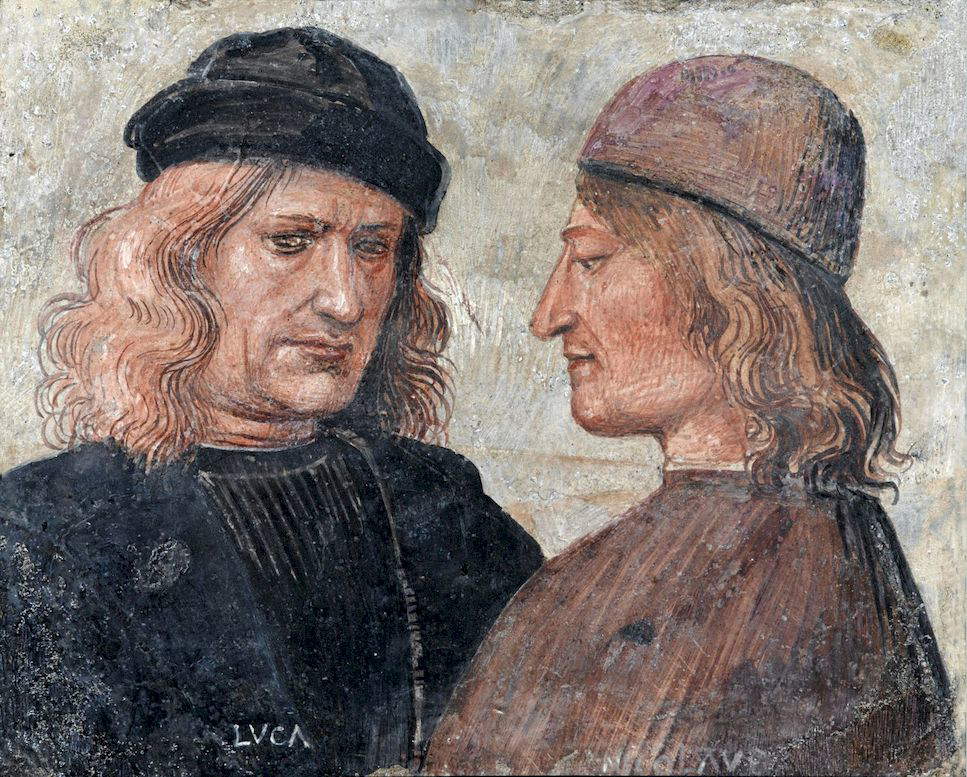 |
| Attributed to Luca Signorelli, Tegola di Orvieto (c. 1504; fresco on brick slab, 32 x 40 cm; Orvieto, Museo dellOpera del Duomo) |
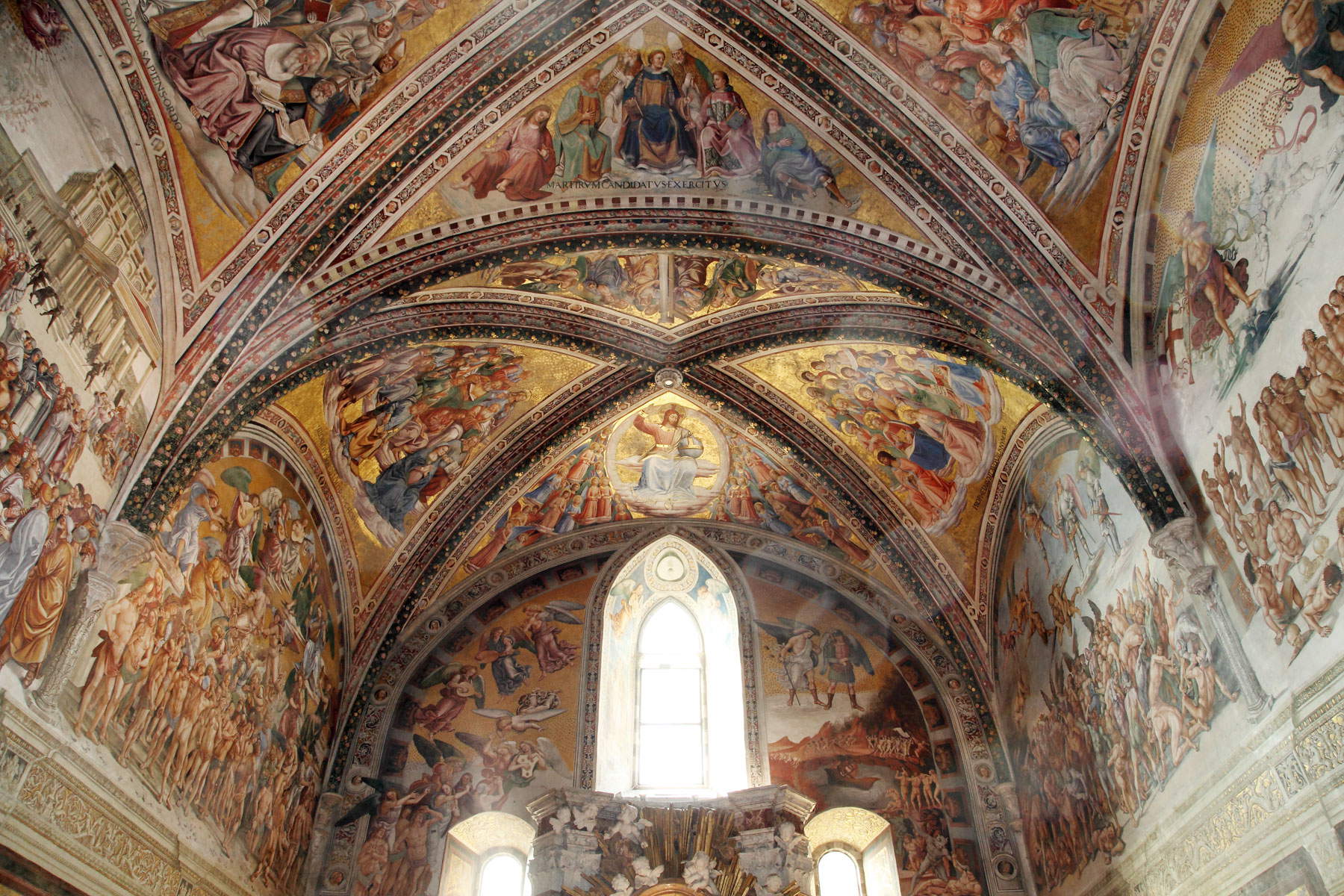 |
| View of the Chapel of San Brizio |
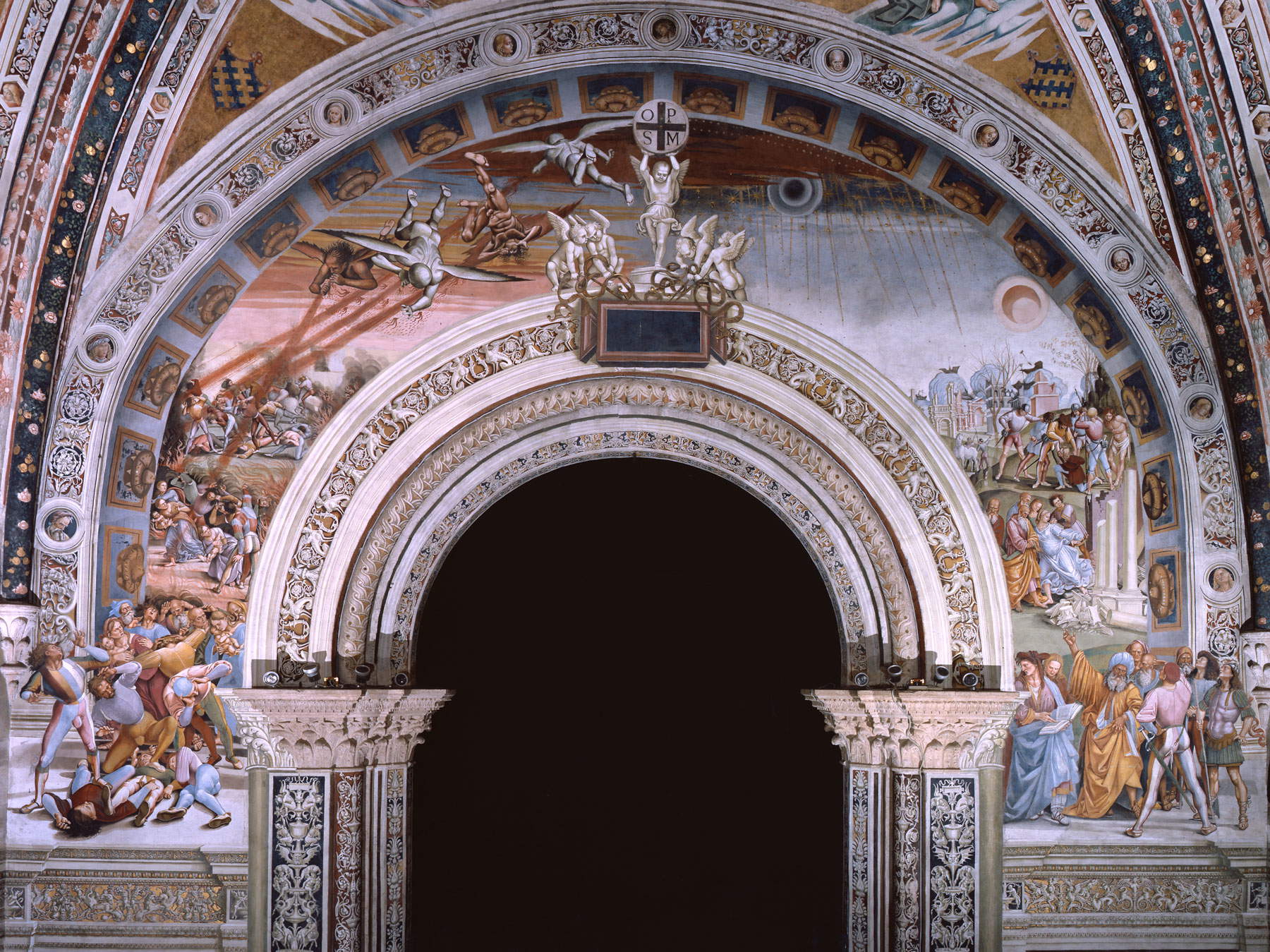 |
| Luca Signorelli, The Finimondo (1499- 1504; fresco; Orvieto, Duomo, Cappella Nova) |
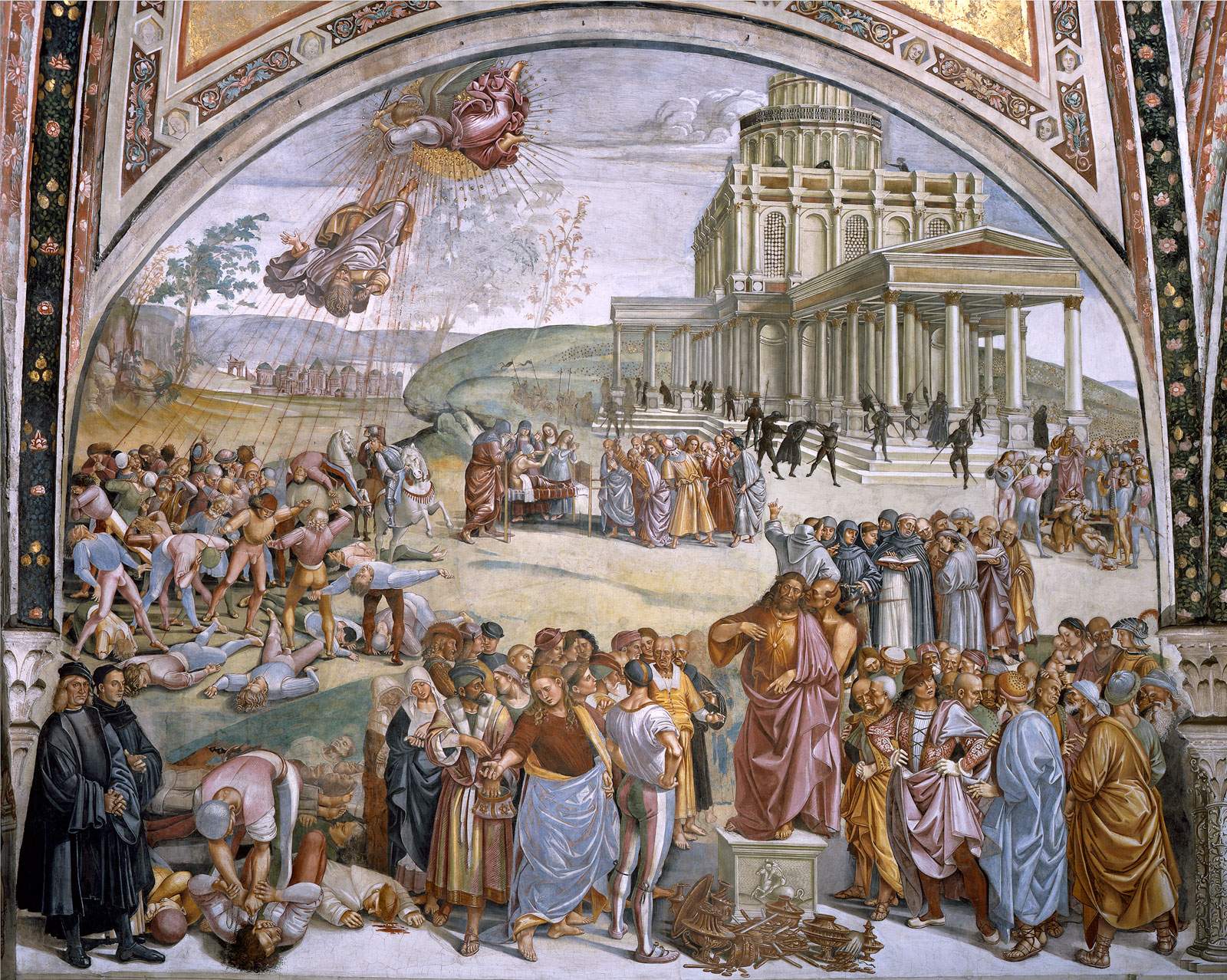 |
| Luca Signorelli, The Preaching of the Antichrist (1499-1504; fresco; Orvieto, Duomo, Cappella Nova) |
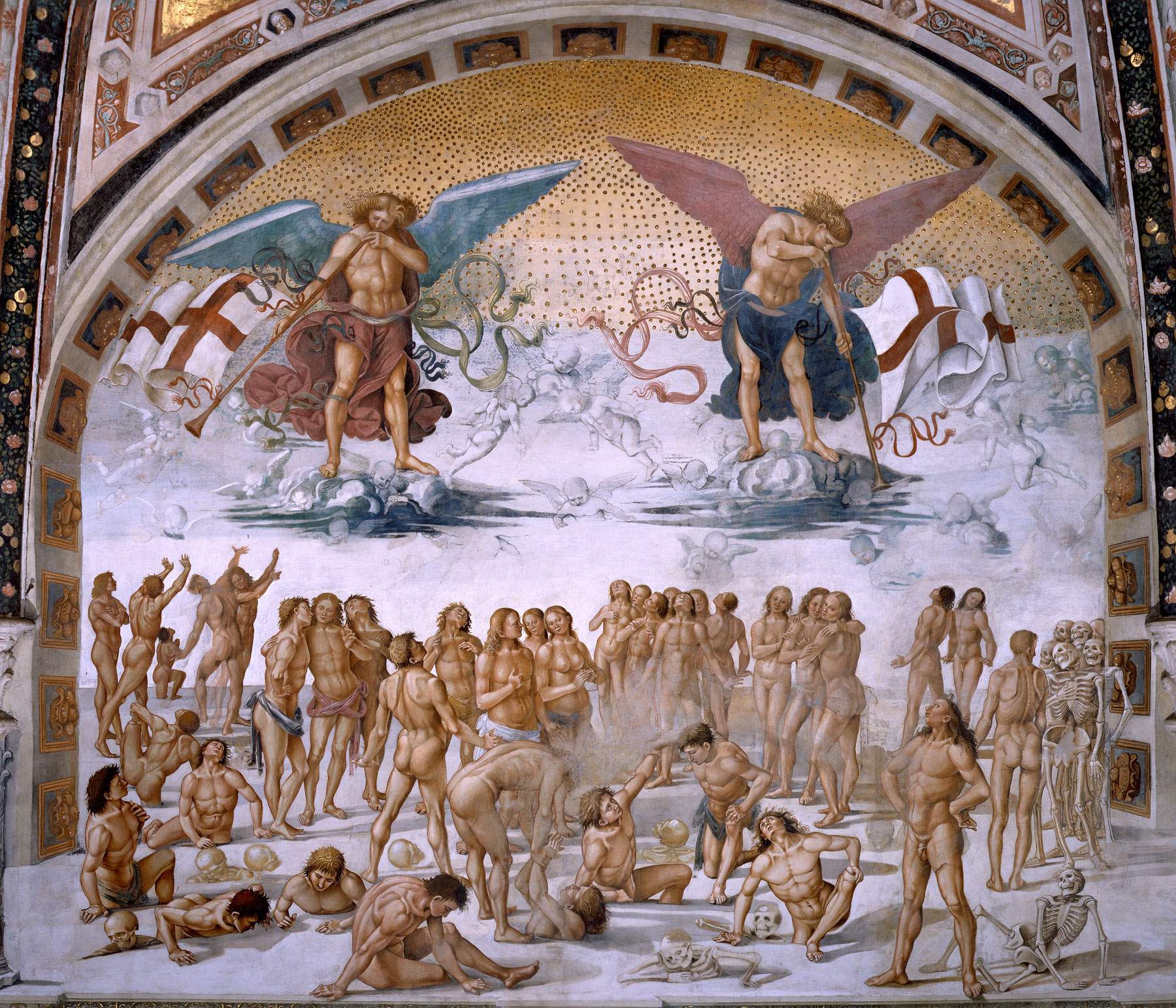 |
| Luca Signorelli, The Resurrection of the Bodies (1499-1504; fresco; Orvieto, Duomo, Cappella Nova) |
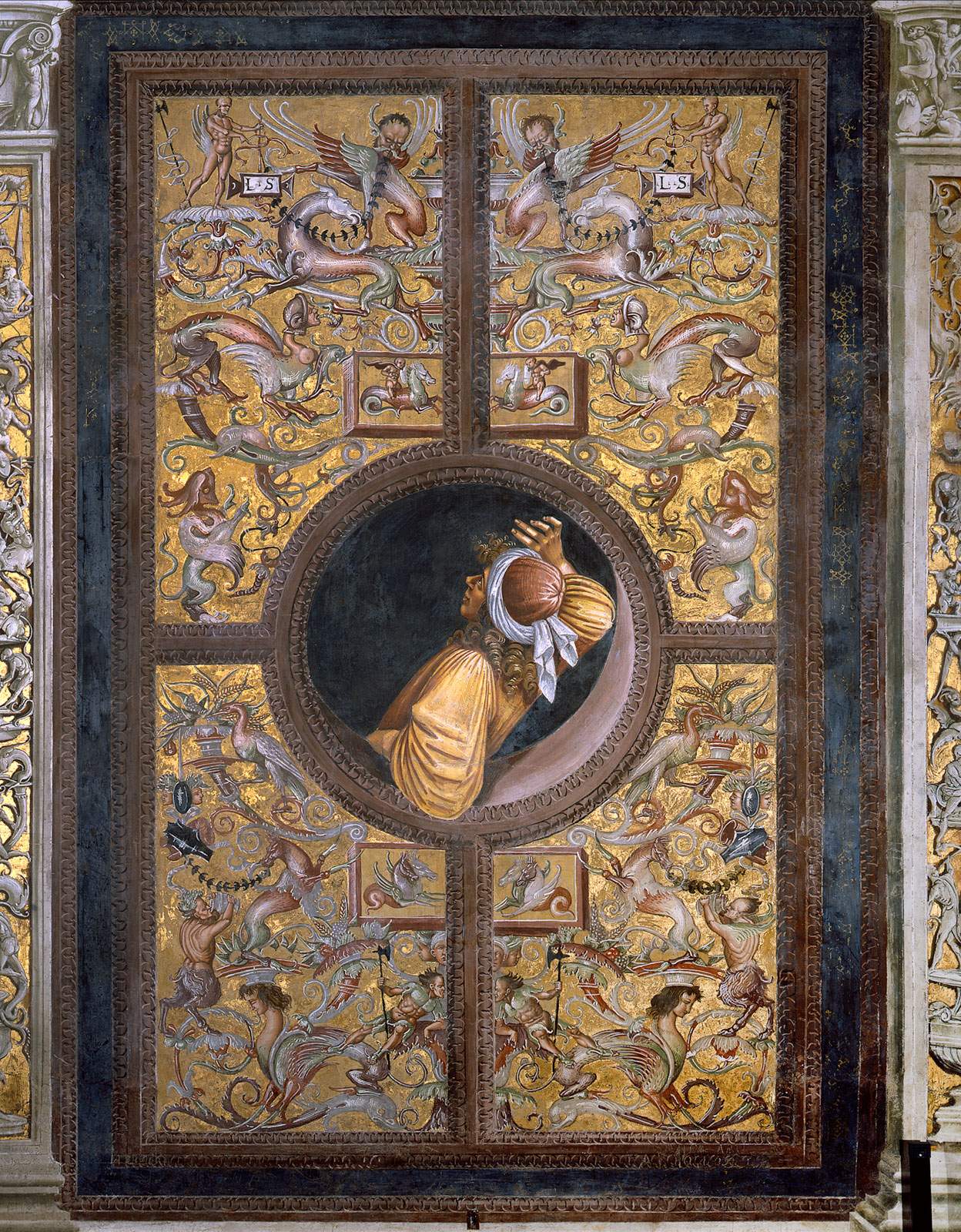 |
| Luca Signorelli, Empedocles (1499-1504; fresco; Orvieto, Duomo, Cappella Nova) |
The reading of Signorelli’s frescoes begins with the lunette depicting the Preaching of the Antichrist. Above a podium the Antichrist, whose face vaguely resembles that of Christ, listens to the words of the Devil drawing inspiration for his sermon. Several narrative cores unfold within an airy landscape setting. A group of characters vainly assembled around the Antichrist and attentive more to displaying their gaudy uniforms than focusing on the impending allocutio, occupy the foreground. The slightly rearmost floor is reserved for a group of friars, belonging to various orders, who are discussing the sacred scriptures. One of them is pointing to the fall of the Antichrist struck down by the sword of the avenging angel. It is the just punishment reserved for the false prophet and his followers who spread death and destruction everywhere: in the background a man, dragged by ferocious thugs, is led to torture; another, in the presence of the Antichrist, is about to be beheaded; even the proscenium is occupied by episodes of crude overpowering. In the midst of such blind violence, the figure of the Jew about to settle his debt with a beautiful sinner is striking. The narrative, which takes place within a space unordered by laws of perspective, appears, as in Pintoricchio, fragmented and dispersed, organized over several visual fires.
But what hides this representation, which foreshadows the end of the world and the birth of a new reality where the weak will find redemption and the righteous eternal bliss? It is now widely believed that Orvieto’s grandiose figuration refers to a historical moment of obvious difficulty for the Church, the one coinciding with the papacy of Alexander VI Borgia and the dramatic events at the end of the fifteenth century that led to the condemnation and murder of Girolamo Savonarola. Beyond the hypotheses formulated, which are not always supported by adequate contextual reconstructions, what Pietro Scarpellini, an unsurpassed interpreter of Signorelli’s pictorial universe, wrote in 1964 still seems relevant: “and the iconographic program was developed in a turbid and dramatic situation. In fact, it seems very likely that the inspirers (theologians or humanists, Orvietani or Romans of the Curia) had established it under the influence of more recent events. We are precisely in the year 1500, a year of spasmodic expectations and millenarian prophecies, which did not fail to find confirmation in the fearful daily reality; and among the most recent events, one did not cease to move and disturb the spirits, the tragic, admonishing end of Gerolamo Savonarola. Now it is well plausible that for the papist Orvietani (and for a painter like Signorelli who was a close friend of the Medici) the friar could embody the Antichrist of theApocalypse. André Chastel, who supports this thesis, brings a weighty argument when he cites theApologia of Marsilio Ficino (written in 1499) where Savonarola is precisely accused of being the false prophet. These arguments, therefore, are already sufficient to explain the presence of two subjects, such as the Preaching and facts of the Antichrist and the Finimondo, so uncommon in Italy.”
Now, going back to Signorelli’s figurative poem, the story of the Antichrist anticipates and prefigures the end of the world, skillfully depicted by the artist in the meager space around the archway to the Chapel. Here, Scarpellini continues, “Luca wants to frighten us; and not so much with the group to the right of the archway where the bad soldier with spread legs, the invaded woman, and the wise old man show off their usual declamatory poses, as in the episode on the left in which the protagonists would even like to rain down on our heads. A torrent of torsos, of heads, of arms, of legs entering the chapel, a screaming torrent that wants to overwhelm us in its own mad terror.” From a kind of porthole, which opens between the exuberant grotesque decorations of the plinth, the pre-Socratic philosopher Empedocles, a convinced advocate of the fact that under the action of Hate, which succeeds in separating from the perfect and beating Sphere the four primordial roots, that is, water, earth, fire and air giving rise to the cosmos and living creatures, the cycle of Love must follow.
The concept, developed and refined by the Christian world, sees as the fundamental stage of the path to salvation the Last Judgment, which is followed by the Resurrection of bodies and the Separation of the reprobate from the elect. Into this discourse fits perfectly the world imagined in Dante’s Commedia and kept in mind in some fundamental passages of the Orvieto cycle; a cycle of great modernity with which the “Cortonese Luca de ingegno et spirto pelegrino,” so sharply defined by Giovanni Santi, father of Raphael, “opened to most artisans the way to the last perfection of art.” this last sentence, placed by Giorgio Vasari at the conclusion of Signorelli’s biography, is meant to allude to the importance that the Orvieto frescoes represented for the world of contemporary art and precipitously for Michelangelo, whose Last Judgment was conceived, in analogy with the Orvieto one, to give a solemn, monumental response to the travails experienced by the Orthodox Church in the 1630s.
This contribution was originally published in No. 5 of our print magazine Finestre Sull’Arte on paper. Click here to subscribe.
Luca Signorelli, the frescoes of the Chapel of San Brizio in Orvieto Cathedral The frescoes that Luca Signorelli (Cortona, 1445/1450 - 1523) painted in Orvieto Cathedral, inside the Cappella Nova (or Chapel of San Brizio), are one of the pinnacles of Renaissance art: powerful work that still leaves open questions about its significance. 1296;1715;1309LOpera del Duomo di Orvieto, after a series of attempts scaling over the span of half a century, finally found in Luca Signorelli the right artist to cover the Nova or San Brizio chapel with mural paintings. The portion of the vault, frescoed by Beato Angelico in 1449 and left unfinished by him, would thus be included in the modern figuration of the Cortona painter. The year 1499 runs and the decoration of the Chapel can resume its course until its completion in 1504. The technical and stylistic break between the two phases is undoubtedly strong. It can be appreciated either by the use of good binoculars or by a close examination of the painted surfaces. I, who had the good fortune to go up on the scaffolding when the restoration of the 1990s was still in progress, had the opportunity to appreciate Angelico’s way of proceeding, faithful to the tradition of the Renaissance workshop and based on the punctual transposition of the cartoons, from that of Signorelli, much looser and substantially freed from respect for workshop rules. It is amazing how the artist is able to design in spurts, simply by resorting to a metal point with which he etches the surface of the fresh plaster. This way of proceeding makes his figurations fresh and vibrant, full of unpredictable effects.
We do not know what was the iconographic-iconological program to which Beato Angelico was supposed to have responded by giving colorful garb to the thought and dictation of some learned theologian. In this regard we can ask whether Luca Signorelli followed the program developed in the mid-15th century or translated a new project into painting. This is not easy to answer. What is certain is that the passage of half a century may have substantially changed the primitive figurative plan. Daltra parte nel contratto che lOpera del Duomo stipula con l’artista viene detto esplicitamente che costui dovrà attenersi, per quanto riguarda i soggetti, al disegno elaborato dal stesso e approvato dai soprastanti allOpera del Duomo (“che sia obligato decto maestro Luca a pegnere le tre facciate de decta capella [ ] et storiarle secundo el disegno dato per lo maestro”). In the so-called Orvieto tile, datable around 1504, actually a terracotta tile painted on two sides (in the first are the portraits of Luca Signorelli and Niccolò di Angelo, the camerarius of the Opera del Duomo who assumed that position on March 1, 1500, in the other runs an elegant humanistic inscription recalling the merits of the two figures) it is said in clear letters that the layout of the stories was made perspicuously (lucidly) with the narrative sequences of the Final Judgment (iudicii finalis ordine) in mind. After all, the theme of the wall decorations had been established as early as November 25, 1499, when magister Lucas de Cortona was called upon to interpret the thoughts of the venerabiles magistros sacre pagine without straying from the iudicii matter. But who are the venarabiles magistros to whom the document refers? Many hypotheses have been formulated: some have brought up Niccolo di Angelo himself who, in agreement with the venerable magistri, provided the artist, defined in the inscription of the tile as eximious, comparable to Apelles in merit, with the iconographic project. On the other hand, Niccolò di Angelo was an influential figure in Orvieto’s history, a notary, conservator of the peace, several times orator in Rome on behalf of the Commune, but above all chamberlain of the Opera del Duomo in the year in which Signorelli received the charge of completing the decoration of the chapel. Of course, other hypotheses are not ruled out, such as the one that sees in the spectabilis vir Giovanni Lodovico Benincasa, the one who, in his capacity as a listened superstes of the Fabbrica del Duomo, at the meeting of November 25, 1499, solemnly taking the floor, invited those assembled to deliberate on the continuation of the decorative undertaking. After all, Niccolò di Angelo and Giovanni Lodovico Benincasa, in 1501, were together oratores in Rome on behalf of the Orvieto community.
Recently there has been a proposal to see nellarcidiacono Antonio Albèri, of Orvietan origin, as responsible for the iconographic choices translated into painting by the Cortona artist. The latter, an authoritative member of the Roman curia, was very close to Cardinal Francesco Todeschini Piccolomini; so much so that, following the latter’s example, he had a library built attached to Orvieto Cathedral, intended to house his precious books. Interestingly, the decoration of the bookcase was done by a follower of Luca Signorelli, perhaps based on a design by Signorelli himself. Laura Andreani and Alessandra Cannistrà, speaking of Canon Albèri, wrote: “The iconographic program of Signorelli’s decorative cycle has been the subject of in-depth interpretations, bringing out in the studies a complexity of iconological levels underlying the images due to the contribution of different personalities called upon to enrich, refine and articulate organically, within the strictest orthodoxy, a new and burning subject for its references to contemporary criticalities. Despite the indifference in this regard of the documents, among the names frequently hypothesized for the scientific advice of the paintings is that of Antonio Albèri (circa 1423 - 1505), an Orvietan canon of the cathedral and archdeacon, who for his own professional affairs divided his existence between Perugia, Siena, Rome and Orvieto, always cultivating his cultural interests and accumulating, with a humanistic vocation, a substantial number of books.” A graduate in utroque, Albèri befriended the humanist Giovanni Antonio Campano and many other intellectuals gravitating around the Piccolomini. Perhaps it was he, having all the characteristics, who suggested the iconographic program that arose from scholarly readings including, in addition to the Vetero and New Testament texts, Virgil, Jacopo da Varazze’s Legenda Aurea, and St. Augustine. Impractical, for reasons of chronology, appears to be the proposal to see in the poem by Giovanni Sulpizio da Veroli, entitled Iudicium Dei supremi de vivis et mortuis and published in 1506, the trace from which Luca Signorelli must have been inspired, who began decorating the chapel in 1499 on the basis of a previously agreed libretto. Much easier is to see in Giovanni Sulpizio’s work a derivation from the theological-doctrinal summa enacted by Signorelli.
 |
| Attributed to Luca Signorelli, Tegola di Orvieto (c. 1504; fresco on brick slab, 32 x 40 cm; Orvieto, Museo dellOpera del Duomo) |
 |
| View of the Chapel of San Brizio |
 |
| Luca Signorelli, The Finimondo (1499- 1504; fresco; Orvieto, Duomo, Cappella Nova) |
 |
| Luca Signorelli, The Preaching of the Antichrist (1499-1504; fresco; Orvieto, Duomo, Cappella Nova) |
 |
| Luca Signorelli, The Resurrection of the Bodies (1499-1504; fresco; Orvieto, Duomo, Cappella Nova) |
 |
| Luca Signorelli, Empedocles (1499-1504; fresco; Orvieto, Duomo, Cappella Nova) |
The reading of Signorelli’s frescoes begins with the lunette depicting the Preaching of the Antichrist. Above a podium the Antichrist, whose face vaguely resembles that of Christ, listens to the words of the Devil drawing inspiration for his sermon. Several narrative cores unfold within an airy landscape setting. A group of characters vainly assembled around the Antichrist and attentive more to displaying their gaudy uniforms than focusing on the impending allocutio, occupy the foreground. The slightly rearmost floor is reserved for a group of friars, belonging to various orders, who are discussing the sacred scriptures. One of them is pointing to the fall of the Antichrist struck down by the sword of the avenging angel. It is the just punishment reserved for the false prophet and his followers who spread death and destruction everywhere: in the background a man, dragged by ferocious thugs, is led to torture; another, in the presence of the Antichrist, is about to be beheaded; even the proscenium is occupied by episodes of crude overpowering. In the midst of such blind violence, the figure of the Jew about to settle his debt with a beautiful sinner is striking. The narrative, which takes place within a space unordered by laws of perspective, appears, as in Pintoricchio, fragmented and dispersed, organized over several visual fires.
But what hides this representation, which foreshadows the end of the world and the birth of a new reality where the weak will find redemption and the righteous eternal bliss? It is now widely believed that Orvieto’s grandiose figuration refers to a historical moment of obvious difficulty for the Church, the one coinciding with the papacy of Alexander VI Borgia and the dramatic events at the end of the fifteenth century that led to the condemnation and murder of Girolamo Savonarola. Beyond the hypotheses formulated, which are not always supported by adequate contextual reconstructions, what Pietro Scarpellini, an unsurpassed interpreter of Signorelli’s pictorial universe, wrote in 1964 still seems relevant: “and the iconographic program was developed in a turbid and dramatic situation. In fact, it seems very likely that the inspirers (theologians or humanists, Orvietani or Romans of the Curia) had established it under the influence of more recent events. We are precisely in the year 1500, a year of spasmodic expectations and millenarian prophecies, which did not fail to find confirmation in the fearful daily reality; and among the most recent events, one did not cease to move and disturb the spirits, the tragic, admonishing end of Gerolamo Savonarola. Now it is well plausible that for the papist Orvietani (and for a painter like Signorelli who was a close friend of the Medici) the friar could embody the Antichrist of theApocalypse. André Chastel, who supports this thesis, brings a weighty argument when he cites theApologia of Marsilio Ficino (written in 1499) where Savonarola is precisely accused of being the false prophet. These arguments, therefore, are already sufficient to explain the presence of two subjects, such as the Preaching and facts of the Antichrist and the Finimondo, so uncommon in Italy.”
Now, going back to Signorelli’s figurative poem, the story of the Antichrist anticipates and prefigures the end of the world, skillfully depicted by the artist in the meager space around the archway to the Chapel. Here, Scarpellini continues, “Luca wants to frighten us; and not so much with the group on the right of the archway where the bad soldier with spread legs, the invaded woman, and the wise old man show off their usual declamatory poses, as in the episode on the left in which the protagonists would even like to rain down on our heads. A torrent of torsos, of heads, of arms, of legs entering the chapel, a screaming torrent that wants to overwhelm us in its own mad terror.” From a kind of porthole, which opens between the exuberant grotesque decorations of the plinth, the pre-Socratic philosopher Empedocles, a convinced advocate of the fact that under the action of Hate, which succeeds in separating from the perfect and beating Sphere the four primordial roots, that is, water, earth, fire and air giving rise to the cosmos and living creatures, the cycle of Love must follow.
The concept, developed and refined by the Christian world, sees as the fundamental stage of the path to salvation the Last Judgment, which is followed by the Resurrection of bodies and the Separation of the reprobate from the elect. Into this discourse fits perfectly the world imagined in Dante’s Commedia and kept in mind in some fundamental passages of the Orvieto cycle; a cycle of great modernity with which the “Cortonese Luca de ingegno et spirto pelegrino,” so sharply defined by Giovanni Santi, father of Raphael, “opened to most artisans the way to the last perfection of art.” this last sentence, placed by Giorgio Vasari at the conclusion of Signorelli’s biography, is meant to allude to the importance that the Orvieto frescoes represented for the world of contemporary art and precipitously for Michelangelo, whose Last Judgment was conceived, in analogy with the Orvieto one, to give a solemn, monumental response to the travails experienced by the Orthodox Church in the 1630s.
This contribution was originally published in No. 5 of our print magazine Finestre Sull’Arte on paper. Click here to subscribe.
Warning: the translation into English of the original Italian article was created using automatic tools. We undertake to review all articles, but we do not guarantee the total absence of inaccuracies in the translation due to the program. You can find the original by clicking on the ITA button. If you find any mistake,please contact us.